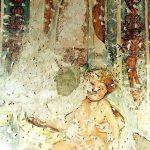The first fresco paintings at the ‘Maestà’ along the road to Arezzo, downstream from Laterina, date back to the second half of the 14th century, as evidenced by the inscription “25 mensis Augusti 1372,” carved by an unknown pilgrim on the surrounding geometric decoration. According to tradition, Saint Bernardino (1380-1444), who was particularly devoted to the Virgin Mary, is said to have preached here. He likely came from Siena, having traveled through the Valdambra and crossed the Arno at Ponte Romito.
It was after his death, which occurred on May 24, 1444, and perhaps in the years immediately following his canonization in 1450, that the “sacellum” (chapel) was re-frescoed, likely commissioned by the people of Laterina or the local lay confraternity dedicated to Mary. That the site, which was then uninhabited and on the edges of the marshes, became a place of worship and pilgrimage during those years is confirmed by other inscriptions: one by a certain Marco, dating precisely to 1450, and another by the Aretine cleric Giovan Battista Ricci, who left this inscription “ad perpetuam memoriam” (for perpetual remembrance) of his visit in 1451:
“For the record, in this chapel Giovan Battista Ricci […], a cleric from Arezzo, rested, his legs very tired from the journey, and his mind was troubled, and from these solitary places he moved to Arezzo on 8 July 1451.”
(For perpetual remembrance, in this chapel, Giovan Battista Ricci, Aretine cleric, rested, very tired in his legs from the journey, and from these solitary places, he moved on to Arezzo on July 8, 1451.)
On the back wall, the Madonna della Misericordia (Madonna of Mercy) was painted, flanked by Saints Anthony and Bernardino. On the left wall, the Crucifixion was depicted, with the castle of Laterina shown in the distance (but outside the frame). In the spandrel, God the Father is shown blessing, with the Holy Spirit above.
The Madonna, whose face is almost illegible, holds open her wide red mantle, lined with blue on the inside, which lovingly embraces the devotees (women on the right and men on the left). Both the male and female figures have very delicate features, with a transparency and luminosity of the skin that evokes the light and color of the Sienese painter Sassetta (late 14th century – 1450), Giovanni di Paolo (1389-1482), or Pietro di Giovanni d’Ambrogio (ca. 1409-1449). The white veil covering the heads of the older women stands out against the Virgin’s mantle, as do the elaborate braided hairstyles wrapped around the neck of a refined lady, or the blonde hair of a young girl in the foreground. Behind the Madonna, two angels hold a drapery in a pose that appears in similar Aretine depictions, but with a more archaic flavor, such as the detached fresco by Giovanni d’Agnolo di Balduccio (d. 1452) in the Monastery of Santa Maria Novella in Arezzo, now housed in the local Museum of Medieval and Modern Art.
In contrast to the Madonna della Misericordia painted by Parri Spinelli (1387-1453) in the Arezzo oratory founded by Saint Bernardino of Siena in 1428 (Santa Maria delle Grazie), the fresco at Laterina abandons all reminiscences of the late Gothic tradition in favor of a Renaissance iconography expressed by the more modern Sienese painters. This connection is more plausible than the attribution to the Florentine workshop of Neri di Bicci (1419-1492), as some have suggested.
The Crucifix is perhaps attributed to the same hand as the previous depiction.
The Madonna in Throne with the Child, however, is from the years 1480-90 and is likely the work of an artist from Arezzo, though with a Florentine training. The fresco is almost entirely lost in the area of the Virgin’s figure, but the Child is still fairly legible. The throne, depicted in central perspective, is enriched on the sides by classical candelabrum motifs, while on its back there is a monochrome decoration of vine scrolls and sun motifs typical of the Bernardino style. The scene is framed by two Doric columns supporting a full arch, characteristic of the new Antiquarian Humanist architecture. However, these elements are rendered in a rather rigid and popular manner, with an uncertain and at times grammatically incorrect use of architectural perspective.
The enlargement of the chapel in the 15th century also included the addition of the oratory on its left side. In this space, around 1480-1485, a Madonna and Child fresco was created, which is the most historically and artistically significant work of the period.
In a niche on the back wall, the Virgin is depicted seated on a throne (mostly lost in the inner part), with the Child on her lap. The niche itself is shaped like a small apse with a shell-like green vaulted form, supported by side pilasters, and framed with a golden border rendered in perspective. The Madonna, heavily repainted in the 19th century, was restored by the S.A.R. company from Florence under the direction of Laura Speranza. These difficult restorations have restored the legibility of the late-15th-century fresco.
The Virgin’s mantle is blue, lined with green, descending from her head and fastened at her chest with a golden button. Her forehead is covered by a translucent white veil. Her robe, a rich ruby red, is secured below the chest with a narrow rose-colored belt tied in a knot. Mary gazes lovingly at the Child, who stands on her lap. He is plump with curly blonde hair, his body almost childishly exaggerated in its fullness, and he holds a swallow in his tiny hand.
The fresco, recently attributed to the Lippi school, bears more resemblance to the style of Andrea del Verrocchio (rather than Filippo Lippi, 1406–1469) or his close collaborators and followers, such as Fra’ Diamante (1430–post 1498). Verrocchio’s influence is particularly noticeable in the beautifully rendered left hand of the Virgin, slender and nervous, as well as in the characteristic knot of the belt tied under her chest.
At the same time, there are unmistakable references to Piero della Francesca’s work, particularly in the regal monumentality of the Virgin’s figure and her pensive expression. As Paolucci has noted, “the deep-rootedness of Piero della Francesca’s art in the interior Tuscany [… ] municipal, feudal, and rural” is evident through artists like Lorentino d’Andrea. It is within the context of this lesser-known artist that we should look for the creator of our fresco. Lorentino d’Andrea, also known as Lorentino d’Arezzo (1430–1506), was a painter who worked alongside Piero della Francesca in the Aretine church of San Francesco and helped to adapt and disseminate his art in a more popular and devout tone, less aristocratic and abstract.
Licia Bertani







